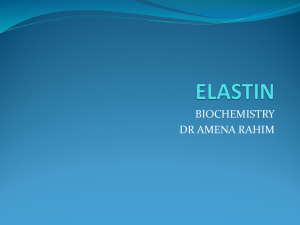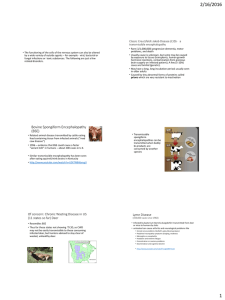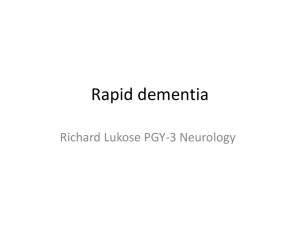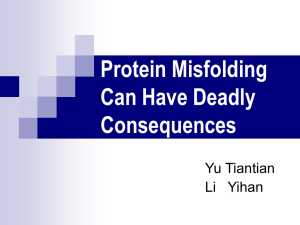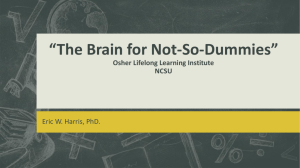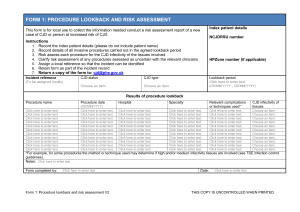An Evaluation of a Suspected Cluster of Creutzfeldt-Jakob Disease (CJD) in
advertisement
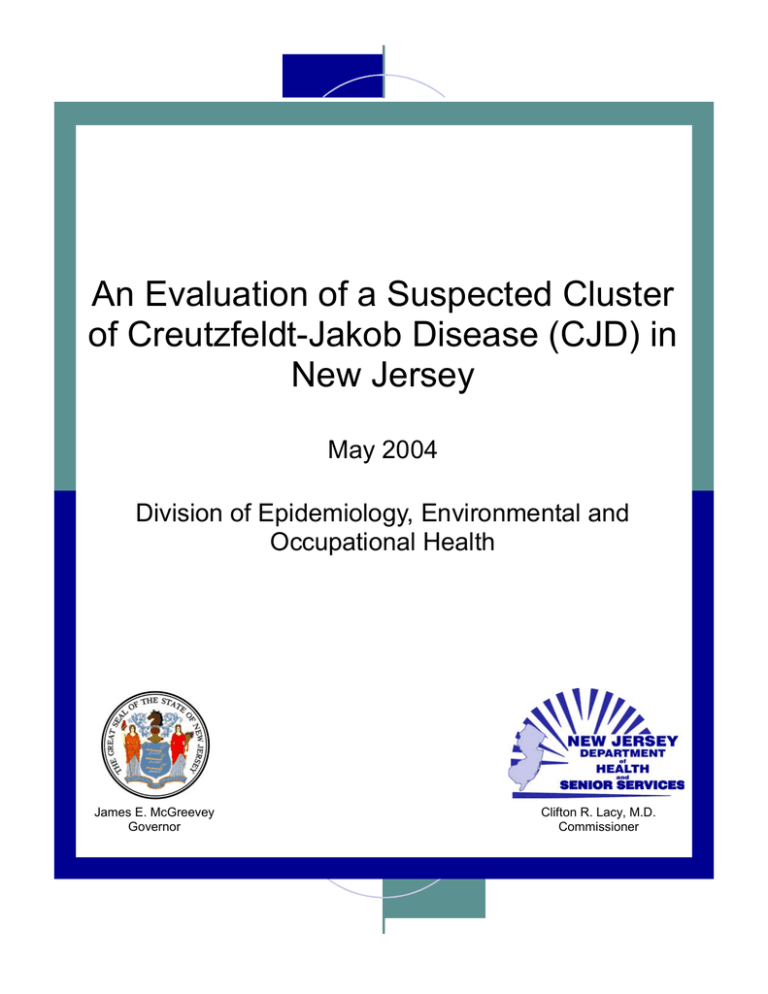
An Evaluation of a Suspected Cluster of Creutzfeldt-Jakob Disease (CJD) in New Jersey May 2004 Division of Epidemiology, Environmental and Occupational Health James E. McGreevey Governor Clifton R. Lacy, M.D. Commissioner An Evaluation of a Suspected Cluster of Creutzfeldt-Jakob Disease (CJD) in New Jersey Eddy A. Bresnitz MD, MS State Epidemiologist/Senior Assistant Commissioner Michal Gerwel, MD Managing Physician Division of Epidemiology, Environmental and Occupational Health New Jersey Department of Health and Senior Services May 7, 2004 Acknowledgements The authors wish to thank Dr. Larry Schonberger of the Centers for Disease Control and Prevention and Dr. Pierluigi Gambetti of the National Prion Disease Pathology Surveillance Center who have worked closely with the New Jersey Department of Health and Senior Services (NJDHSS) on CJD surveillance efforts for many years. Their efforts in the past year are especially appreciated. The authors thank many others within and outside the NJDHSS for their helpful comments in preparing this report. 2 Table of Contents A. Introduction 4 B. Epidemiology of CJD 4 C. Surveillance for CJD in the US and NJ 7 1. United States 7 2. New Jersey 8 D. Investigating disease clusters/outbreaks 10 1. Background 10 2. Previous CJD clusters 11 E. Suspected CJD cluster at the former Garden State Racetrack, Cherry Hill, NJ 11 1. Identifying and verifying the diagnosis 11 2. CJD in NJ counties nearest the GSRT 13 3. Determining the rate of CJD among GSRT attendees 14 4. Potential exposures to BSE-contaminated beef 16 5. Evaluation of suspected cluster of CJD 17 F. Future CJD surveillance plans in New Jersey 18 1. General 18 2. Continued evaluation of suspected CJD cluster at the GSRT 19 G. References 20 3 A. Introduction In June 2003, a New Jersey (NJ) resident informed the New Jersey Department of Health and Senior Services (NJDHSS) and the Centers for Disease Control and Prevention (CDC) with her suspicion that a cluster of Creutzfeldt-Jakob disease (CJD) was associated with attendance at the now-closed (2001) Garden State Racetrack (GSRT) in Cherry Hill, New Jersey. The informant (JS) hypothesizes that the individuals who make up the suspected cluster ate meat that was contaminated with the agent causing bovine spongiform encephalopathy (BSE). She speculates that this meat was served at the GSRT food service areas from 1988 to 1992. This report describes relevant features of the epidemiology of CJD, discusses methods used for surveillance of CJD, and evaluates the alleged cluster. B. Epidemiology of CJD Creutzfeldt-Jakob disease (CJD) is a rare and uniformly fatal neurodegenerative disease characterized by a rapidly progressive dementia, muscle twitching and a characteristic electroencephalogram (EEG) pattern. CJD is caused by an “unconventional” filterable agent, a unique protein (“prion”) that replicates by a poorly understood mechanism. Prions are agents that cause transmissible spongiform encephalopathies (TSEs) in humans and many animal species. TSEs include scrapie in sheep, bovine spongiform encephalopathy (BSE or “ Mad Cow Disease”) in cattle and CJD in humans (Belay, 2002). There are three major forms of CJD: sporadic, inherited (or familial) and acquired by infection (Gambetti, 2003). Based on considerable scientific data, leading prion disease scientists maintain that sporadic CJD occurs in the absence of an outside source of infection due to the spontaneous transformation of normal prion proteins into abnormal disease-causing prions. Five subtypes of sporadic CJD have recently been described. Of these five CJD subtypes, one subtype accounts for 60-70% of all case-patients with sporadic CJD (Parchi, 1999). Sporadic CJD occurs in every region of the United States (US) and in most other countries of the world at a rate of approximately one case per million population per year. Notably, the rate of sporadic CJD varies with age. Sporadic CJD occurs at a rate of approximately 4.1 cases per million in individuals age 55 years or higher, and at a much lower rate of 0.12 cases per million in individuals under age 55 (Gibbons, 2004). Like all other forms of TSEs, all forms of CJD are invariably fatal. Those affected usually die within a year from the time of symptom onset, making mortality rates useful surrogates for incidence rates. In the US, approximately one in every 9,000 deaths (including those under 50 in whom CJD is extremely rare) is due to sporadic CJD. Inherited TSEs are caused by the presence of abnormal genes encoding prion proteins that can spontaneously transform into a disease-producing prion leading to familial CJD. The familial form accounts for 10-15% of all forms of CJD. 4 The form acquired by infection includes the iatrogenic CJD most commonly caused by implantation of “prion infected” tissue from an undiagnosed individual who was incubating CJD (CDC, 2003). A striking type of acquired CJD is variant CJD (vCJD). It was first recognized in 1996 in the United Kingdom (UK) and was causally linked to an outbreak of BSE in an estimated million or more infected cattle that was first documented in the UK in 1986. A CDC report stated that the “…Epidemiologic and laboratory evidence suggest that the BSE agent was transmitted to humans via consumption of BSEcontaminated cattle products” (CDC, 2003). Variant CJD is easily distinguishable from all the subtypes of sporadic (classic) CJD. Table 1 (pg 6) summarizes the numerous clinical, laboratory and histopathologic features that distinguish vCJD from sporadic CJD (Table 1) (CDC, 2004). Additional important differences can be detected by examining the abnormal prion protein associated with vCJD and sporadic CJD (Will at al, 2004). Also, all vCJD case-patients have neuropathologic findings distinctly different from those of classic CJD (Ironside, 1998). CJD can also be classified differently into classic and variant categories. Classic CJD would include sporadic, familial and iatrogenic forms of the illness. Figure 1 illustrates the wide age disparity in those with vCJD in the UK (median age at death: 28 years) compared with those with sporadic disease in the US (median age at death: 68 years), with minimal overlap in the frequency distribution. The age distribution of sporadic CJD case-patients in the UK is similar to the distribution of CJD case-patients in the US. Figure 1. From: CDC. MMWR 2004; 54: 1280-1285. 5 Table 1. From: CDC. MMWR 2004; 54: 1280-1285. The number of definite clinical case-patients with BSE among cattle in the UK peaked in 1992 and the number of patients who died secondary to CJD (~150) appears to have peaked in 2000 (Figure 2). Figure 2. From: Donnelly, NEJM 2004; 350: 539-542. 6 The only reported case-patient with vCJD involving a US resident occurred in an individual who was born and raised in the UK during the peak period of human exposure to BSE (CDC, 2002). The number of sporadic CJD case-patients diagnosed in the UK between 1997 and 2003 has remained relatively constant. During this same period, however, the number of vCJD case-patients had increased dramatically (www.cjd.ed.ac.uk). It has been suggested that consumption of BSE-infected material may cause sporadic CJD. Although one study reported that certain BSE-infected mice produced prions with a molecular phenotype consistent with a subtype of sporadic CJD (Asante et al, 2002), these animal data cannot be reliably extrapolated to humans in the absence of other supporting evidence. In 2003, the Spongiform Encephalopathy Advisory Committee of the United Kingdom concluded that these data did “not provide strong evidence to support” the hypothesis that exposure to BSE can produce a sporadic CJD-like illness in humans (European SEAC, 2004). C. Surveillance for CJD in the US and NJ 1. United States The CDC coordinates surveillance efforts for detecting, confirming and reporting CJD in the US (Belay, 2003). As with all diseases, states have the statutory authority for determining which diseases that occur among their residents must be reported to public health officials. A state records a case of disease if the person is diagnosed with the disease while a resident of that state. Currently, about half the states in the US, including New Jersey, require physicians and others to report diagnosed or suspected patients with CJD to the local or state health department. Some states only require reporting those case-patients under age 55. The CDC and all states collect death certificate data that can be used to detect potential case-patients. The CDC works through states to investigate CJD reports in persons aged <55 years to identify possible patients with vCJD. The World Health Organization (WHO) has developed criteria for classifying potential case-patients with CJD as definite, probable and possible. In definite case-patients, the diagnosis has been definitively established through examination of tissue obtained from a brain biopsy or autopsy. Generally, the diagnosis is confirmed not only by histological examination but also by techniques that demonstrate the presence of the abnormal prion protein. Probable case-patients have the clinical and laboratory features of CJD, without brain tissue confirmation. Possible cases have compatible clinical features but no corroborating EEG, laboratory or tissue data. Figure 3 shows that the overall rate of CJD in the US has been constant at approximately one case of CJD per million population per year. The figure also shows that dramatic differences in age-specific rates. 7 Figure 3 From: Gibbons et al: JAMA 2000; 284:2322-2323. Given the size of the US population, approximately 300 cases of CJD are expected to occur every year in the US. Since 1985, the number of reported deaths with CJD as the underlying diagnosis in the US has been relatively stable, averaging 253 cases annually through 2001 (L. Schonberger. Personal communication, 2004). In the mid-1990’s, the CDC established the National Prion Disease Pathology Surveillance Center (NPDPSC) in Cleveland, OH to “…provide advanced neuropathologic and biochemical diagnostic services free of charge to US physicians and state and local health departments. These surveillance efforts have not detected any cases of indigenous vCJD in the US” (CDC, 2004). In recent years, the NPDPSC has examined pathologic samples from approximately 250 potential case-patients with CJD per year, has confirmed close to 800 case-patients with CJD since its inception, and is the recognized authority in assessing suspected CJD case-patients (www.cjdsurveillance.com). 2. New Jersey New Jersey made CJD a reportable disease in 1989, although the state has reported CJD mortality data for many years prior to 1989. There was no attempt to routinely confirm or classify reported individuals or case-patients with CJD listed on death certificates in New 8 Jersey prior to 2002. In addition, before 2002, NJDHSS only included physician reports in its published statistics; none of the reported case-patients were categorized according to the WHO classification scheme. Since 2002, the NJDHSS has evaluated all physician-reported case-patients and those discovered through death certificate review or hospital billing data using a short form prepared by NJDHSS. All suspected case-patients involving individuals <55 years that come to the attention of the NJDHSS, from whatever source, are evaluated using an abstract form designed by the CDC. Staff contacts the medical provider(s) and requests medical records for review. Where available and not already done, NJDHSS facilitates the review of brain tissue and laboratory specimens by the NPDPSC. Since 1997, the NPDPSC has examined tissues from 16 case-patients from New Jersey. Since 1979, mortality surveillance (underlying cause of death listed on the death certificate) has recorded an annual average of 7 individuals diagnosed with CJD in New Jersey, with a range of 3 to14 in any given year (Figure 4). Although the number of casepatients fluctuates from year to year, this is a normal and expected pattern. Patients with CJD have occurred in all counties but one, with no more than three case-patients in a county in any given year. In any one year, the majority of NJ counties have had no documented CJD case-patients. Since 1996, these surveillance data have revealed no more than ten reported case-patients with sporadic CJD per year among New Jersey residents. Figure 4 Number of CJD Cases in New Jersey 16 14 12 10 8 6 4 2 2003 2001 1999 1997 1995 1993 1991 1989 1987 1985 1983 1981 1979 0 Case counts for 1979 to 2001 are from the National Center for Health Statistics underlying cause of death file. Counts for 2002 and 2003 are from the Communicable Disease Service and the New Jersey Vital Statistics database in the NJDHSS. 9 As with any surveillance system, some case-patients may not be identified or reported and some non- case-patients may be incorrectly labeled as CJD (either through physician reporting or listing on a death certificate). Some have suggested that people with CJD may be misdiagnosed as having Alzheimer’s disease. However, people with Alzheimer’s disease generally have a very distinct clinical course, with a prolonged illness of progressive dementia without other neurological features. In general, statistics on reported CJD cases should be viewed as reasonable estimates of the true occurrence of the disease among NJ and US residents. D. Investigating disease clusters/outbreaks 1. Background The CDC defines a disease cluster as “…an unusual aggregation of health events that are grouped together in time and space and that are reported to a health agency” (CDC, 1990). Clustering of disease may be spatial, temporal or both. Clustering that takes place in both time and space occurs when, for a given period of time, incidence, prevalence or mortality rates of a particular disease are higher in some places than in others. When an unusual number of cases of a disease are noticed in a particular place and time period, there are four possible explanations for the excess. The first is an aggregation of persons with age, race, gender or other factor distribution that puts them at inherently higher risk; the second is a higher prevalence of risky lifestyle/behavior factors; the third is the exposure to some external factor, which subsequently caused the disease; and the fourth is chance. A spatial-temporal cluster may be the result of normal variation because random events are not expected to occur in a perfectly uniform pattern. An important distinction between a cluster that is a potential health concern and one that is not is whether there is a common etiology among cases. In the case of an external agent, documenting both the existence of the agent and a common exposure pathway from the agent to individuals is necessary, at a minimum, to suggest that a causal association exists. The first step in an assessment of a perceived cluster is to establish a list of suspected case-patients and to verify whether or not they have the disease based on established criteria. Generally, only definite and probable case-patients, as defined by the disease diagnostic criteria, are included in the subsequent analysis. The next step in a cluster investigation is to assess whether the incidence of the disease over time exceeds what would be expected. Expected numbers and rates are usually based on historical state and/or national data. Key to this phase of the analysis is to identify the population of individuals that have had the opportunity to be exposed to the agent and the pathway suspected of causing illness. If the data indicate a significant increase in the observed over the expected numbers and rates of disease, the next step in an investigation is to determine the need and feasibility of further investigation. This could include a case-control study where information on 10 past exposures is obtained directly from the individuals with the disease of interest (or the next-of-kin or friends when the patient has died) and a matched control group without the disease (or their next-of-kin or friends) who are from the same population from which the cases arose. 2. Previous CJD clusters The outbreak of vCJD in the UK could be considered a cluster of vCJD in space (UK) and time (1995 to the present) related to an exposure (e.g. food contaminated with the BSE prion). The causal association is strengthened by the similarity of the pathologic findings in humans with vCJD, and the molecular and experimental studies showing the common etiologic agents in cattle and humans. The rise of vCJD (Figure 2) parallels the incidence of BSE, with a lag (incubation) period of about 10 years. Although the evidence supports a causal relationship, clearly the risk of disease is low given that only ~150 individuals have developed vCJD despite the consumption of potentially contaminated meat by tens of millions of people (CDC, 2004). We are aware of only one reported investigation of a relatively large (over 15 casepatients) suspected cluster of CJD in the US. Little et al. reported 18 case-patients of classic CJD between 1988-1990 in the Lehigh Valley, PA, five times the expected incidence. The investigators interviewed close relatives of these patients and matched controls to assess differences between the case and control groups. “No statistically significant associations of animal exposure, food ingestion (other than cheese) or surgery/trauma were identified.” Travel (both international and US) and having a springfed water supply were associated with CJD, “…however, the patients with CJD in this study lived as far as 50 miles apart from each other, making a point source exposure unlikely” (Little, 1993). The authors did not consider any of these associations convincing (B. Little. Personal communication, April 9, 2004). E. Suspected cluster of CJD at the former Garden State Racetrack, Cherry Hill, NJ 1. Identifying and verifying the diagnosis The informant contacted the NJDHSS and the CDC in mid-June 2003 with her concerns that there was a cluster of CJD case-patients associated with attendance or employment at the Garden State Racetrack (GSRT) in Cherry Hill, NJ, which closed in 2001. The informant’s hypothesis is that affected individuals ate BSE-contaminated meat at the GSRT between the years 1988 and1992. Initially, JS provided staff in NJDHSS with names of three suspected case-patients. By late July, NJDHSS had determined that, of the three case-patients, one was classified as a definite case and one as not a case of spongiform encephalopathy (i.e., no CJD-related pathogenic prion protein was detected by the NPDPSC in brain tissue that was tested multiple times). JS did not provide identifying information about the third case-patient until mid-January 2004. At that time she provided a list of 10 individuals (including the initial three) to both CDC and NJDHSS. 11 As of the date of this report, JS has provided names of 16 individuals whom she believes had CJD and had some association with the GSRT. All 16 individuals are deceased. The Virginia Department of Health reported an additional case-patient, also deceased, to the NJDHSS. Nine of the 17 individuals reported to the NJDHSS were residents of other states (PA, CT, VA, MD, DE) at the time of diagnosis. NJDHSS staff have worked and continue to work with the CDC and these other states to determine the status of the individuals on this list. As is routinely done, NJ, PA, CT, VA, and MD health officials contacted providers (where that information was available) and requested medical records and brain tissue (when available) for review by the NPDPSC (if not already done). All those with definite or probable CJD to date had classic CJD and were over the age of 55, except for one person who was 50 (CDC, 2004). Table 2 summarizes the evaluation to date. Table 2. Status of patients reported by the informant as suspected of having Garden State Racetrack-related CJD Case Age Death State Tissue examination Diagnosis Other (where) Comments 1 70 1997 NJ Yes (NPDPSC) Definite Autopsy 2 3 4 67 70 56 1997 2002 2003 NJ NJ NJ Yes (not NPDPSC) Yes (NPDPSC) Yes (NPDPSC) Definite Definite Definite Autopsy Brain Bx Autopsy 5 6 78 29 2004 2000 VA PA Yes (NPDPSC) Yes (NPDPSC) Brain Bx Autopsy 7 59 2004 PA Yes (NPDPSC) 8 72 2004 NJ Yes (not NPDPSC) 9 10 11 12 13 14 15 59 83 50 70 71 68 72 1997 2000 2001 2001 2003 2003 1995 PA NJ CT MD NJ PA PA No No No No No No No Definite Other diagnosis Other diagnosis Other diagnosis Probable Probable Probable Probable Probable Probable Unknown 16 61 1995 PA Unknown Unknown 17 69 1996 DE Unknown Unknown Autopsy Autopsy Under investigation Under investigation Under investigation NPDPSC = National Prion Disease Pathology Surveillance Center 12 To date, 11 of the 17 patients reported by the informant have been determined to be definite or probable classic CJD case-patients. All those with definite or probable sporadic CJD to date were over the age of 55 at the time of death, except for one person (# 11 in the table) who was 50. The mean age of the 11 definite/probable patients at the time of diagnosis was 67.4 years. Nine case-patients were men. Six of the 11 casepatients were residents of NJ, two were residents of Pennsylvania, and one each were residents of Virginia, Connecticut and Maryland. Reported case-patients classified as definite or probable classic CJD occurred in the period 1997 to 2004. All persons throughout the world with BSE-related vCJD tested as of January 2004 have had a specific genetic make-up characteristic of about 40% of the general population. None of the three pathologically confirmed CJD case-patients who were tested for this marker were documented to have it. Case # 6 is the index case-patient identified by the informant. The tests carried out at the NPDPSC show that the index case-patient did not have variant or sporadic CJD (P. Gambetti. Personal communication, April 12, 2004). Upon review of the available information on this patient, CDC staff confirmed that not only there was compelling genetic and immunochemical evidence that the patient's illness was not related to BSE, but also that the histopathology showed evidence against a diagnosis of CJD. None of the other five patients who had brain tissue submitted for examination at the NPDPSC were documented to have vCJD, the form associated with BSE exposure. Rather, either had a non-prion disease or a form of sporadic CJD that differed from each other. These laboratory data do not indicate a common etiology. 2. CJD in NJ counties nearest the GSRT As described earlier, expected numbers of cases and rates are based on historical data. Based on an overall rate of one case of classic CJD per million population per year, the expected annual number of CJD case-patients in New Jersey is about eight. An average annual rate of over two cases per million, or about 16 cases annually in New Jersey would be considered very unusual, based on NJ, US and European data. In every year, the majority of NJ counties had no reported case-patients (data not shown). Overall, based on underlying cause of death data, there have been an average of 7.5 cases per year in New Jersey and 2.1 cases per year in the seven South Jersey counties closest to the GSRT. Based on the 1990 and 2000 populations of the seven counties, approximately 1.7 case-patients per year would be expected. Observed numbers of case-patients have remained fairly constant, with normal variation over the years (Figure 5). It is clear from Figure 5 that in relative terms, there has been no consistent disproportionate increase in the number of case-patients in the seven South Jersey counties, where the majority of GSRT attendees and employees most likely resided. If consumption of BSEcontaminated beef at the GSRT between 1988 and 1992 caused sporadic CJD, the data should show increases in the numbers of case-patients by now, assuming the same lag (incubation) period as vCJD. 13 Figure 5 Number of CJD Cases in New Jersey 2003 2001 1999 1997 1995 1993 1991 1989 1987 1985 1983 1981 1979 16 14 12 10 8 6 4 2 0 Case counts for the seven South Jersey counties (Atlantic, Burlington, Camden, Cape May, Cumberland, Gloucester, Salem) are shown in blue. Case counts for the remaining 14 counties are shown in maroon. Case counts for 1979 to 2001 are from the National Center for Health Statistics underlying cause of death file. The counts for 2002 and 2003 come from the Communicable Disease Service and the New Jersey Vital Statistics database in the NJDHSS. There is no evidence of an increasing number of CJD case-patients in adjacent Philadelphia county, 1995-2001 (L. Schonberger. Personal communication, April 28, 2004) or in New York City (Nivin, 2004). 3. Determining the rate of CJD among GSRT attendees To calculate incidence rates of CJD, epidemiologists need a numerator consisting of definite/probable cases, and a denominator of the population-at-risk for developing disease. Because of the small number of CJD case-patients in any year, rates are expressed per million, in contrast to the usual reporting of rates of disease (per 100,000). In 2000, the population of New Jersey was about 8.4 million, and that of South Jersey (location of the GSRT) was 1.75 million. Thus the average annual rate of CJD in New Jersey and South Jersey, based on underlying cause of death reported case-patients, was about the expected value of 1 per million population. The low number of case-patients per county in any given year precludes the determination of meaningful county rates since no county in NJ has a population greater than 1,000,000. Since five of the definite/probable case-patients on the list were residents of other states, they cannot be included in a calculation of a rate, based on a New Jersey population alone. If we were to 14 include in the numerator all the definite/probable cases who were residents of other states in calculating rates, we would also have to include their populations in the denominators to calculate the incidence rate for the combined states. If we knew the actual population of unique individuals who attended and ate at the GSRT (to better define the population-at-risk), we could calculate the rate of CJD in that population. Those who ate at the GSRT include employees, season pass holders and others who attended regularly from 1988-2001 but did not have a season pass. The names on the informant’s list include individuals who ate only once at the GSRT (Maxx, 2004). If we were to include an individual who had definite/probable CJD who ate only once at the GSRT in the numerator to calculate an incidence rate, we would be obliged to include all individuals who ate at least once at any time at the GSRT between 1988 and 1992 or other period of concern in the denominator. Although we have attendance records for on-site racing for those years, attendance records do not provide information on the number of unique individuals who visited the racetrack. As a result of the above, it is not possible to calculate a reasonably valid incidence rate of sporadic CJD for people who ate (or ate beef specifically) at the GSRT during the years of concern. Another way of examining the issue is to assess what number of deaths in the GSRT attendee population could be expected to be due to CJD. Considering that people who attend the racetrack tend to be older (R.Orbann. Personal communication, April 14, 2004), we could expect that during the time period of interest (1993-present) some of those individuals would die of CJD. There were at least 4.14 million admissions to the GSRT between 1988 and 1992 (New Jersey Racing Commission records). This does not include employees, people who went to the track for off-track betting on non-racing days (year round), and people who visited the track for social events. If just 600 individuals visited the track on non-racing days, we can estimate an additional 600,000 visits to the GSRT from 1988-1992. The informant estimates through her sources that there were 350,000 to 600,000 unique individuals visiting the track during those years (e-mail JS to M. Gerwel, 3/29/2004). We have no basis to estimate how frequently these individuals, including those who had a season pass, attended the racetrack. If we assume conservatively in the years of concern that 250,000 to 500,000 unique individuals over the age of 55 attended the GSRT at least once (an average of 100,000 new customers per year). In addition, we know the incidence of CJD among individuals over 55 years of age is about 4 per million per year (Gibbons, 2000). Therefore, from 1993-2004 (through April) we could expect approximately 1 to 2 cases/deaths due to CJD per year among this GSRT-associated age cohort. The aggregate expected number over this 12-year period is 12-24 case-patients with sporadic CJD. This range is clearly only an estimate and the expected number could be higher or lower than this range allowing for statistical variation. Even with adjustment in this estimated population for deaths each year due to other causes (data not shown), the number of definite or probable case- 15 patients identified to date (11) is within the estimated range and does not support the hypothesis that an outbreak or cluster related to the GSRT exists. This estimate of expected CJD case-patients applies to ANY similar population of individuals. We would expect this number of individuals to develop CJD among 250,000 to 500,000 unique individuals over the age of 55 from 1993-2004 who spent any amount of time between 1988 and 1992 at any other racetrack, for example, in New Jersey or another state. Many of the same individuals may have visited another racetrack and the GSRT or had some other common experience that had nothing to do with the development of their illness. 4. Potential exposures to BSE-contaminated beef The informant’s presumptive cause of the suspected cluster of sporadic CJD is the consumption of BSE-contaminated beef by attendees/employees at the GSRT between 1988 and 1992. However, this hypothesis is speculative in that there is no evidence then or even now of significant contamination of the US beef supply with the BSE prion. Although testing for BSE over the years has been limited, it has focused on animals with neurological symptoms, those most likely to have BSE. The incubation period for BSE in beef (the time from when an animal becomes infected until it first shows disease signs) is from 30 months to eight years with only a few rare exceptions in younger animals (USDA, http://www.usda.gov/). In addition, virtually all cattle consumed in the US are under 30 months of age when slaughtered, thus minimizing the likelihood of their having BSE or of their tissues being infectious. The only documented BSE positive cattle in the US to date was one animal that was recently diagnosed in the Northwest US, and the source of this animal was Canada (CDC, 2004). In 1989, the US Department of Agriculture banned the importation of all ruminants and restricted the importation of certain cattle products from the UK and other countries where BSE was diagnosed. A country is added to the list of countries as BSE is discovered in native cattle in that country (T. Gomez. Email communication, April 29, 2004). Three restaurants and about a dozen concession stands served food at the GSRT. A single national food vendor supplied all these retail outlets (R. Orbann. Personal communication, April 14, 2004). This vendor delivered boxed beef purchased from distributors to other restaurants throughout the region and nationally (D. Barbato. Personal communication, May 6,2004), and yet there is no evidence of a change in incidence of sporadic CJD during this time period in the region or nationally based on death certificate data. If eating BSE-contaminated beef causes sporadic CJD, and this presumed contaminated beef was sold throughout the region and nationally, we would expect to see an increased incidence. Again, it should be emphasized that there was no unusual increase in sporadic CJD in the UK during the period when vCJD incidence was rapidly rising and to this day. 16 In any case, New Jersey Administrative Code regulations do not require food retailers to retain records of where they purchase their food supplies (except for shellfish where records must be kept for 90 days). We are unaware of any records in New Jersey available from the now demolished GSRT that would permit the tracing of beef purchased at any time during its existence. Finally, there is no accurate, objective information available describing what, if any, and how much beef any of the definite or probable case-patients listed in Table 2 may have eaten during their visit(s) to the GSRT. Obtaining histories from people on what they ate several years earlier is notoriously inaccurate. Since all the CJD case-patients are deceased, researchers would have to obtain histories on what individuals ate at the GSRT over a decade ago from next-of-kin or friends. Since the case-patients were elderly when they died, the closest next-of-kin or friends may also have died, thus making a food history even more difficult to obtain. Of course, the same questions on previous food consumption would have to be posed to the next-of-kin or friends of a matched set of control individuals who frequented the GSRT and died of some other disease. These controls would serve as a basis of comparison to determine if indeed there were differences in food histories between case-patients and controls. A difference in the proportion of CJD case-patients who ate beef at the GSRT versus non-CJD case-patients would still not constitute evidence of a causal association. Without any food records or beef samples from that time period, any association would be inconclusive. 5. Evaluation of suspected cluster of CJD The evidence does not support the existence of an outbreak of CJD among attendees at the GSRT, nor does it suggest that case-patients with CJD were exposed to BSEcontaminated beef in the period 1988 to 1992 or at any other time at the Garden State Racetrack in New Jersey. a. The largest and earliest cattle outbreak of BSE in the world occurred in the UK and to date the number of infected cattle has been many orders of magnitudes greater than the number of reported probable and definite vCJD cases in the UK. Thus, an outbreak of either variant or sporadic CJD in the US without more evidence of BSE in this country is extremely unlikely. b. All persons throughout the world with BSE-related vCJD tested as of January 2004 have had a specific genetic make-up characteristic of about 40% of the general population (Will et al, 2004). None of the three pathologically confirmed CJD casepatients who were tested for this marker were documented to have it. c. The UK’s National CJD Surveillance Unit reports no evidence that sporadic CJD has been caused by BSE. There was an increase in sporadic CJD in the UK from 1990-1996 due to improved case ascertainment (SEAC, 2004). This is to be expected for any disease 17 following the institution of a new and active surveillance system. However, there has been no unusually high incidence of sporadic forms of CJD from 1997-2003 in the UK, despite the much heavier exposure of the UK population to the BSE agent between 1980 and 1996 compared to the US population (UK Department of Health). d. Ongoing comparisons of exposures of sporadic CJD case-patients with controls in Europe, as conducted and interpreted by experts in the UK, have been reported to provide no convincing evidence of an increased risk of sporadic forms of CJD through dietary habits (Will et al., 2004). e. As illustrated in Figure 1, all but two of the presumed food-related deaths due to the BSE agent in the UK occurred in person younger than 55 years of age. In contrast, based on the information available at NJDHSS through April 2004, 10 of the 11 decedents with definite or probable CJD between 1995-2003 about whom JS has raised concerns were >55 at the time of death. f. None of the six patients in this report who had brain tissue submitted for examination at the NPDPSC were documented to have vCJD, the form associated with BSE exposure. Rather, they each had either a non-prion disease or form of sporadic CJD that differed from each other. These laboratory data provide scientific evidence against a theory that any of these illnesses were related to each other or to BSE. h. There is no evidence of an increased number of CJD case-patients in the region closest to the GSRT, in adjacent Philadelphia County, or in New York City. F. Future CJD surveillance plans in New Jersey 1. General The key to investigating potential causes of CJD in the US is to encourage brain autopsies of all patients who die of suspected CJD. New Jersey is among the states that require reporting by medical providers of suspected case-patients with CJD. Because physicians nationally and in NJ generally do an inadequate job of reporting all reportable diseases, states use additional methods to ensure as complete ascertainment of cases of interest as possible. The NJDHSS currently also reviews NJ hospital billing data and death certificate data to detect case-patients with CJD that were not reported by physicians, making it more likely to have complete ascertainment of case-patients than other states. The CDC also reviews national mortality data from the National Center for Health Statistics. When a CJD case-patient under 55 years of age is reported, the CDC contacts the state health department to review the details of this case-patient. The NJDHSS periodically sends out to all physicians in the state, and to every newly licensed physician, information on reporting requirements for all diseases and conditions listed in the Administrative Code regulations (N.J.A.C. 8:57), including CJD. The NJDHSS plans to notify physicians in the next few months about the recently adopted 18 revised regulations pertaining to all reportable diseases, including materials such as pocket cards and magnets to remind physicians and other health care providers about their reporting responsibilities. In addition, the NJDHSS will be sending a specific letter prepared by the NPDPSC to neurologists and pathologists, informing them of the need to consider CJD in the differential diagnosis of a patient with a rapidly progressive neurological disorder with dementia, and the free services provided by the NPDPSC. Furthermore, the NPDPSC is prepared to make arrangements and provide for the costs of the autopsy. The NJDHSS will continue to review all suspected cases-patients with CJD detected through passive reporting by health providers, and by reviewing hospital billing data and death certificate data. It will encourage physicians to obtain permission from family members for autopsies of suspected case-patients at the time of death and submit brain tissue and other laboratory data to the NPDPSC for expert analysis. The CJD program at the CDC also has notified the NJDHSS that it intends to provide limited funds, as it does to several other states, to enhance CJD surveillance activities in the state. The NJDHSS plans to enhance education on prion disease, targeted to neurologists and pathologists, the physicians most likely to be in a position to diagnose a potential case of CJD. Unfortunately, autopsies in general are now only rarely done and this is especially true for suspected CJD case-patients where pathologists are reluctant to perform autopsies (Louie at al, 2004). However, as a result of the effort made by the autopsy program of the NPDPSC, the number of autopsies performed in CJD casepatients is currently close to 60% of the number of expected cases. 2. Continued evaluation of the suspected CJD cluster at the GSRT The NJDHSS will update its report on the suspected cluster of CJD case-patients at the GSRT once it receives the information from the pending case-patients. If there are additional reported case-patients that need to be assessed, the NJDHSS will evaluate those that were NJ residents, and will refer the non-NJ resident case-patients to other states for evaluation, where appropriate. Given the epidemiologic and pathologic evidence described above, the NJDHSS believes that conducting a case-control study by interviewing next-of-kin or friends of the definite and probable cases is unwarranted at this point for assessing the proposed hypothesis that BSE-contaminated beef in the US caused an increased incidence or cluster of CJD cases in New Jersey. The proposed hypothesis is not supported by the weight of the evidence presented in this report and the CDC report (CDC, 2004a) to justify conducting such a research project that is very unlikely to yield meaningful information. 19 G. References Asante EA, Linehan JM, Desbruslais M, et al. BSE prions propagate as either variant CJD-like or sporadic CJD-like prion strains in transgenic mice expressing human prion protein. EMBO J 2002;23:6358-6366. Belay ED and Schonberger LB. Variant Creutzfeldt-Jakob disease and bovine spongiform encephalopathy. Clin Lab Med 2002; 22: 849-862. Belay ED, Maddox RA, Gambetti P, and Schonberger LB. Monitoring the occurrence of emerging forms of Creutzfeldt-Jakob disease in the United States. Neurology 2003; 60: 176-181. Brown P, Will RG, Bradley R, Asher DM and Detwiler L. Bovine spongiform encephalopathy and variant Creutzfeldt-Jakob disease: background, evolution, and current concerns. Emerg Infect Dis 2001; 7: 6-16. CDC. Guidelines for investigating cluster health events. MMWR 1990; 39 (RR-11): 1-16. CDC. Probable variant Creutzfeldt-Jakob disease in a U.S. resident—Florida, 2002. MMWR 2002; 51: 927-929. CDC. Update: Creutzfeldt-Jakob disease associated with cadaveric dura mater grafts— Japan, 1979-2003. MMWR 2003; 52: 1179-1181. CDC. Bovine spongiform encephalopathy in a dairy cow—Washington State, 2003. MMWR 2004; 52: 1280-1285. CDC. Creutzfeldt-Jakob disease not related to a common venue-New Jersey, 1995-2004; MMWR 2004a; 54: May 7th, 2004. Donnelly CA. Bovine spongiform encephalopathy in the United States—an epidemiologist’s view. NEJM 2004; 350: 539-542. European Spongiform Encephalopathy Advisory Committee. Final minutes from 77th Annual Meeting, February 11, 2003; http://www.seac.gov.uk/minutes/final77.pdf. Gambetti P, Kong Q, Zou W, Parchi , and Chen SG. Sporadic and familial CJD: classification and characterization. Brit Med Bull 2003; 66: 213-239. Gibbons RV, Holman RC, Belay E, Schonberger LB. Creutzfeldt-Jakob disease in the United States: 1979-1998. JAMA 2000; 284: 2322-2323. 20 Little BW, Mastrianni J, DeHaven AL, Brown P, Goldfarb L, Gajdusek C. The Epidemiology of Creutzfeldt-Jakob disease in Pennsylvania. Neurology 1993; 43: A316. Ironside JW. Neuropathologic findings in new variant CJD and experimental transmission of BSE. FEMS Immunol Med Microbiol 1998;21:91–95. Louie JK, Gaval, Belay ED, Hammond LH, Sconberger L, and Vugia DJ. Barriers to surveillance for Creutzfeldt-Jakob disease and other emerging prion diseases in California. International Conf on Emerg Infect Dis 2004. Atlanta, GA. Maxx T. The New York Times Magazine, March 28, 2004. Nivin B, Colon-Serrant A. Creutzfeldt-Jakob disease surveillance: findings in New York City, 2001-2003. International Conf on Emerg Infect Dis. March, 2004. Atlanta, GA. Parchi P, Giese A, Capellari S, Brown P, Schulz-Schaeffer W, Windl O, Zerr I, Budka H, Kopp N, Piccardo P, Poser S, Rojiani A, Streichemberger N, Julien J, Vital C, Ghetti B, Gambetti P, Kretzschmar H. Classification of sporadic Creutzfeldt-Jakob disease based on molecular and phenotypic analysis of 300 subjects. Annals of Neurology 1999; 46: 224-233. SEAC. Spongiform Encephalopathy Advisory Committee (SEAC) of the United Kingdom, Final minutes of the 77th meeting, February 11, 2003, accessed at http://www.seac.gov.uk/minutes/final77.pdf on April 27, 2004. p 10. Tyler KL. Creutzfeldt-Jakob Disease. NEJM 2003; 348: 681-682. United Kingdom Department of Health, Statistics on definite and probable CJD cases in the UK, April 5, 2004, accessed at http://www.dh.gov.uk/assetRoot/04/07/90/10/04079010.PDF on April 27, 2004. Will RG, Alpers MP, Dormont D, Schonberger LB. Infectious and sporadic prion diseases. In: Prusiner SB, ed. Prion Biology and diseases, Cold Spring Harbor Laboratory Press, Cold Spring Harbor, New York, 2004; 629-671. World Health Organization. World Health Organization infection control guidelines for transmissible spongiform encephalopathies: report of a World Health Organization consultation. Geneva, Switzerland: World Health Organization, March 1999. World Health Organization. The revision of the surveillance case definition of variant Creutzfeldt-Jakob disease (vCJD). Geneva, Switzerland: World Health Organization, May, 2001. 21
